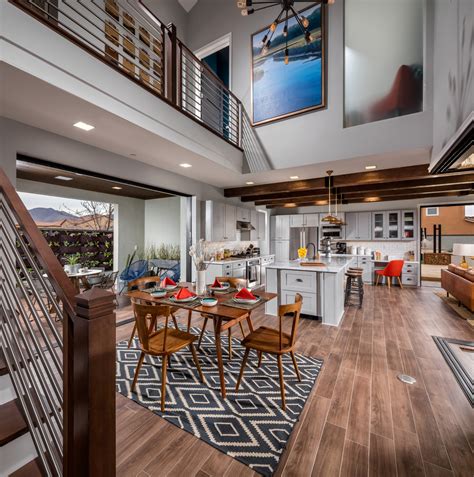Unlock Hidden Potential: 2-Story Ceiling Height Solutions
High ceilings in a two-story space present unique design challenges and opportunities. That soaring height can feel overwhelming or even cavernous, but with the right approach, it can become a stunning focal point and add significant value to your home. This article explores various solutions to unlock the hidden potential of your two-story ceiling height, transforming a potential drawback into a design masterpiece.
What are the Challenges of a Two-Story Ceiling?
Before diving into solutions, it's important to acknowledge the common challenges associated with double-height spaces. These include:
- Feeling of Vastness: The sheer scale can feel cold, empty, or even intimidating, lacking the cozy ambiance of a more conventionally sized room.
- Heating and Cooling Inefficiency: Conditioning such a large volume of air can be costly and less efficient.
- Furniture Placement: Furnishing a double-height room effectively requires careful planning to avoid the space feeling disproportionate or sparsely populated.
- Lighting: Adequate lighting requires a strategic approach, often combining multiple light sources to avoid dark corners and uneven illumination.
How to Design a Two-Story Ceiling: Solutions to Maximize the Space
Now, let's delve into practical solutions that transform these challenges into opportunities:
1. Defining Zones and Creating Intimacy
One effective strategy is to visually break up the space into distinct zones. This can be achieved through:
- Architectural Features: Incorporating a mezzanine level, a partial wall, or strategically placed bookshelves can create defined areas for different functions, such as a reading nook, a dining area, or a home office.
- Strategic Furniture Placement: Using large-scale furniture, such as an oversized sofa or a statement piece of art, anchors the space and prevents it from feeling empty. Consider using rugs to delineate different areas.
- Color and Texture: Employing a warm color palette on the walls and incorporating textured elements like wood paneling can create a sense of warmth and intimacy.
2. Optimizing Lighting for Impact
Addressing lighting is crucial in a two-story space. Avoid relying solely on overhead lighting. Instead:
- Layered Lighting: Combine ambient lighting (recessed lights or chandeliers), task lighting (table lamps, floor lamps), and accent lighting (wall sconces or spotlights) to create depth and interest.
- Vertical Illumination: Consider tall, slender floor lamps or wall sconces to draw the eye upwards and emphasize the height of the ceiling.
- Natural Light: Maximize the use of natural light through large windows or skylights.
3. Choosing the Right Furniture and Decor
Furniture selection plays a vital role in balancing the proportions of the room.
- Scale Matters: Choose furniture that's appropriately sized for the space. Avoid small, delicate pieces that will be lost in the vastness.
- Verticality: Tall, slender pieces of furniture can help to visually connect the floor and ceiling, adding a sense of proportion.
- Statement Pieces: Incorporate one or two statement pieces, such as a grand piano, an oversized artwork, or a striking chandelier, to draw the eye and create a focal point.
4. Utilizing the Vertical Space
Don't let the height go to waste! Consider:
- Gallery Walls: Showcase your artwork or collections with a vertical gallery wall, drawing attention upwards and adding visual interest.
- Floating Shelves: Maximize wall space with floating shelves for books, plants, or decorative items.
- Tall Bookcases: Create floor-to-ceiling bookshelves to add character and functionality.
5. Addressing Heating and Cooling
The vastness of a two-story ceiling can impact heating and cooling efficiency. Consider:
- Zoned Heating and Cooling: Install a zoned heating and cooling system to control the temperature in different areas of the room independently.
- Improved Insulation: Ensure proper insulation in the walls, ceiling, and windows to minimize heat loss or gain.
- Ceiling Fans: Use large ceiling fans to circulate air effectively and improve energy efficiency.
Frequently Asked Questions (FAQ)
How do I make a two-story ceiling feel less cavernous?
By strategically employing zoning techniques, lighting solutions, and appropriate furniture, you can create a sense of intimacy and warmth, reducing the feeling of vastness.
What are the best window treatments for a two-story ceiling?
Consider floor-to-ceiling drapes or blinds to add warmth and control natural light effectively. Avoid shorter treatments, which might accentuate the height without providing a cozy feel.
What type of paint is best for a two-story ceiling?
Lighter, warmer paint colors generally work best to make the space feel more inviting and less overwhelming. Avoid dark colors that can make the space feel smaller and more closed-in.
How much does it cost to renovate a two-story ceiling?
The cost of renovating a two-story ceiling varies significantly depending on the scope of the project, including materials, labor, and any structural modifications. Detailed quotes from contractors are essential.
By carefully considering these design solutions, you can transform your double-height space from a challenging area to a stunning and functional feature of your home. Remember, the key is to balance the scale of the room, create intimacy, and highlight the architectural drama of the height.

